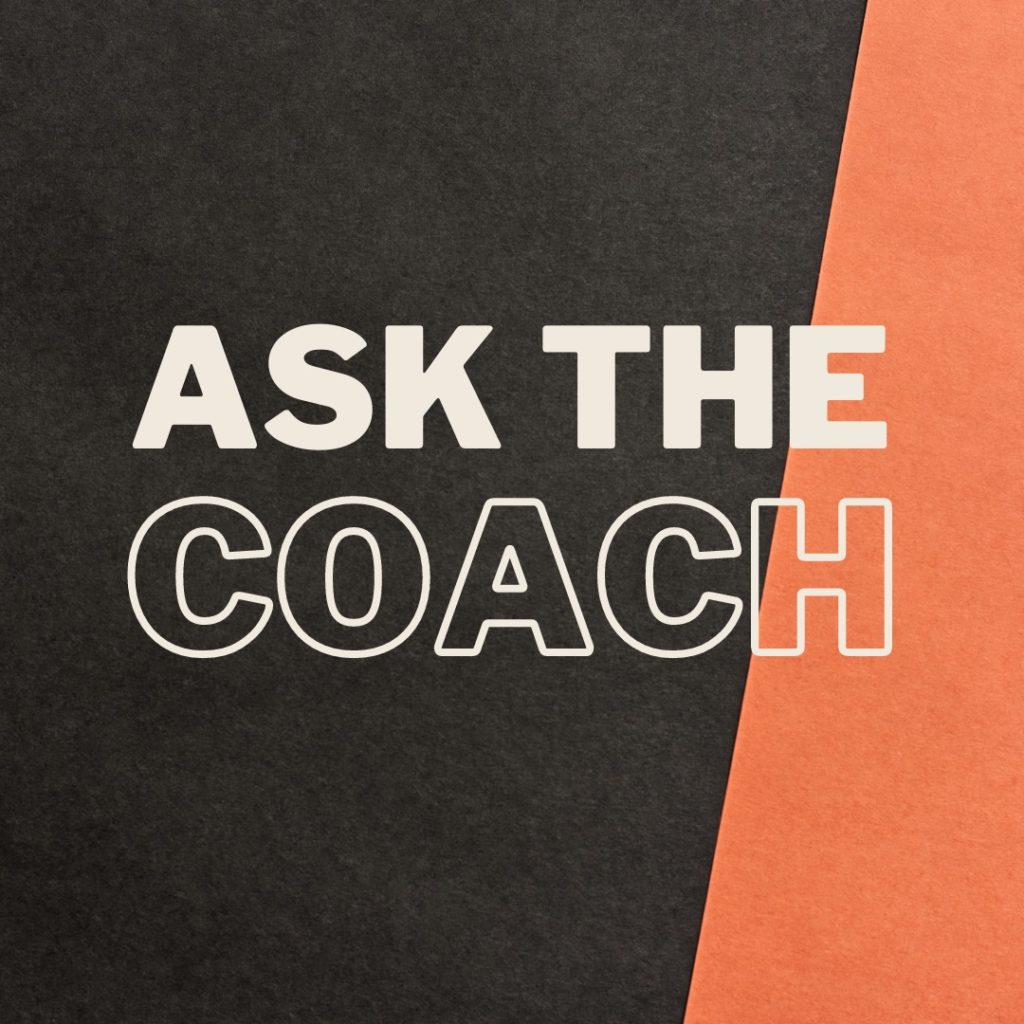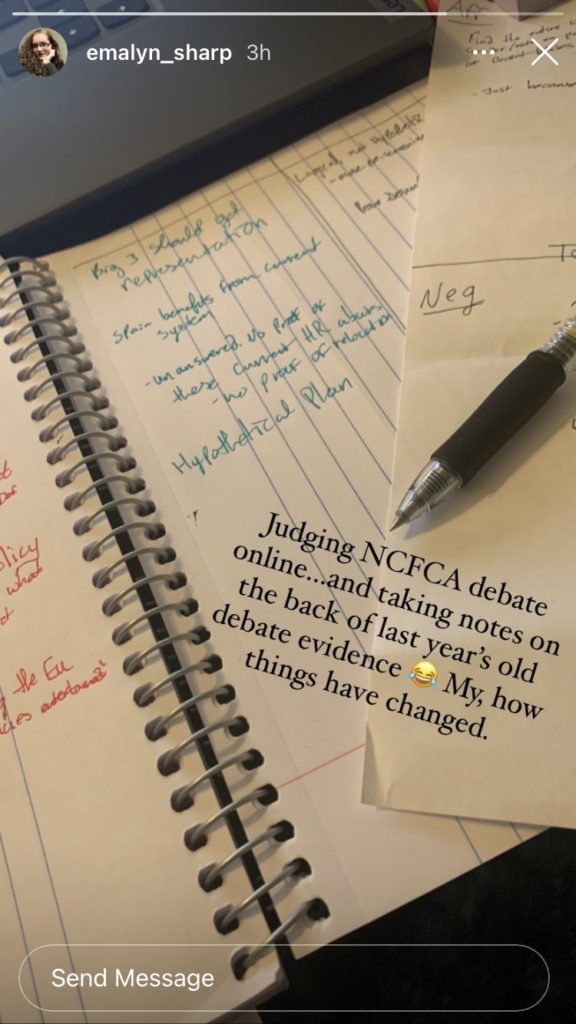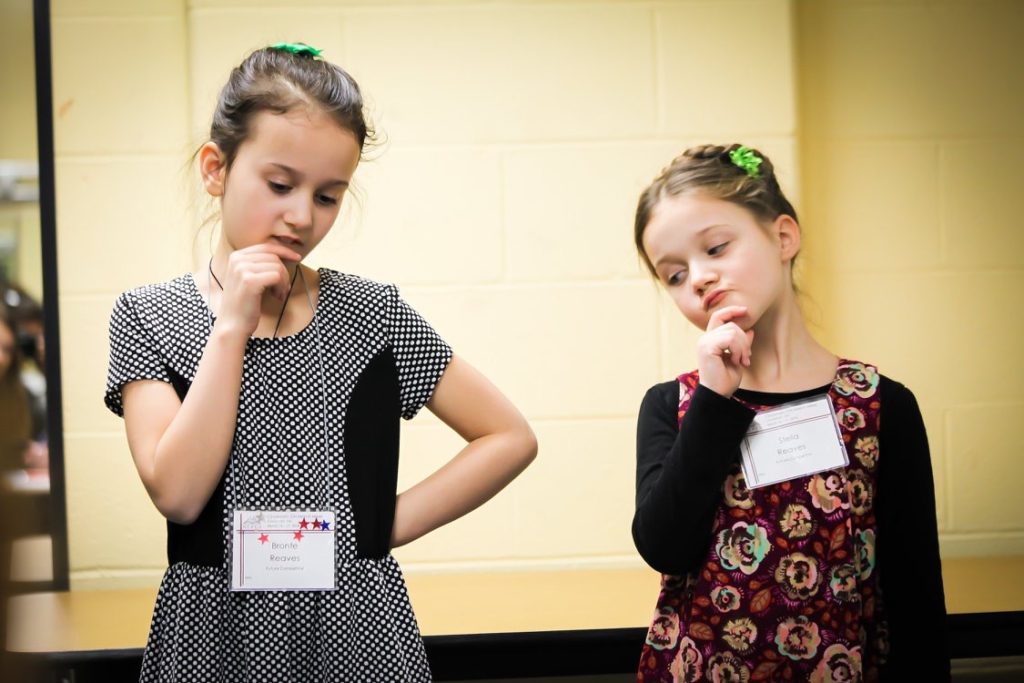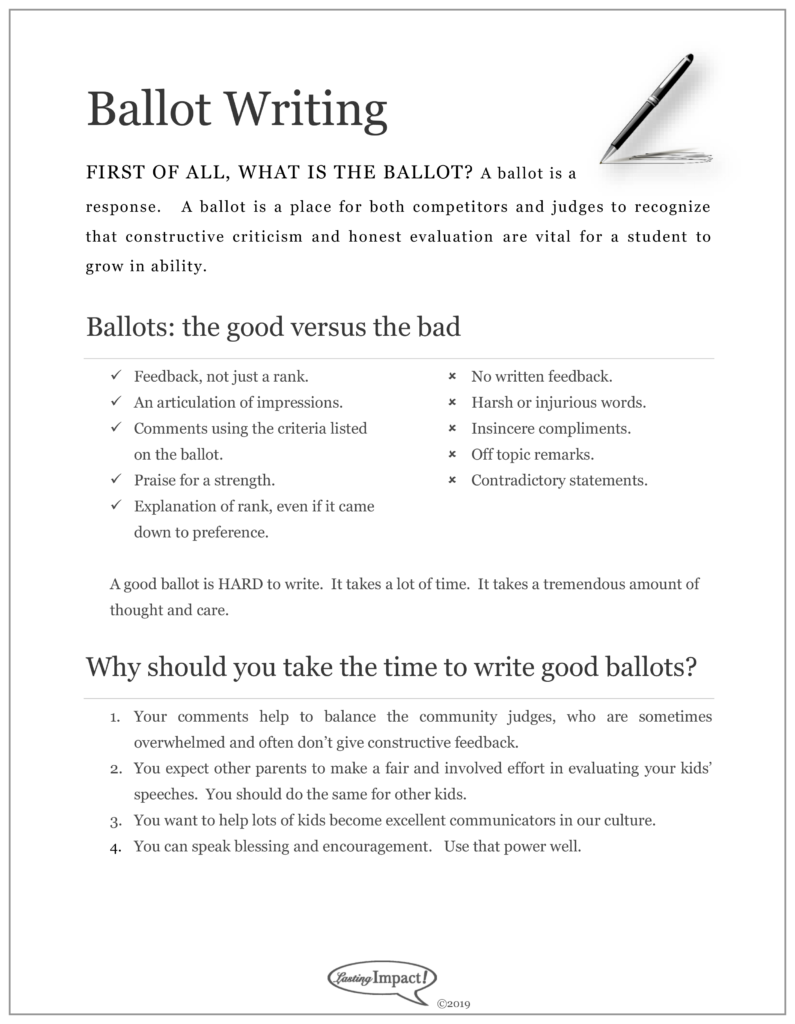
At almost every tournament I go to, people don’t feel qualified to judge. Spectators say to me, “I’m not qualified to judge,” or, “I don’t know what to write,” or even “You can find someone else better to judge, rather than me.” Parents, can also, often feel the same way- whether they are judging at a tournament, giving feedback at club, or working with their own student! My friend, Julie Sanders spoke to the moms of her club on the value of giving feedback. She and her family participated in Speech and Debate for 8 years with their three boys. “I learned and gained so much from our time with NCFCA.” Here is what she had to say on giving feedback…
“Wounds from a friend can be trusted, but an enemy multiplies kisses.” Prov. 27:6
Why do we need feedback?
We need to give constructive feedback to our children/students/competitors so they will learn and grow as communicators. How else are they going to grow? Feedback gives us a connection between what we are doing and saying (something we have control over) and the impression we are making on the audience (something we don’t have control over). Feedback gives insight on whether we are hitting or missing the mark. When it is given in the right spirit, we can improve in areas in which we may or may not be aware of our weakness. Just like having spinach in your teeth, you want to know about it, even if it’s embarrassing or uncomfortable. While many moms feel insecure to give feedback, we can help the students through being uncomfortable and learn to do better next time.
Critique vs. Criticize.
Critique is to evaluate (a theory or practice) in a detailed and analytical way. Not ignoring the good points, a critique is a thoughtful, detailed evaluation. Criticize is to indicate the faults of someone or something in a disapproving way. You criticize when you state your opinion with no positives.
My friend and speech coach, Tim Downs says, “Work with what they’ve got – don’t overturn what they’ve done. Find something in what they are doing that you can improve upon. You don’t want to recreate someone in your own image. Don’t want to say, ‘What you’re doing is wrong, so I’m replacing it.’ Don’t do it.”
How to Share Critique
Give OREO critiques – sandwich the suggestions between two positives.
First give one positive and be encouraging, even if the only thing the student did well was to stand in front of you and say a few words. Oftentimes, I point out that the first time is the hardest time. Now that’s behind them! Don’t give empty flattery (i.e. an enemy’s kisses). Don’t say it’s good if it’s not. The students need to know where they stand to learn and grow.
Positive observations need to be:
Specific – articulate the specific gesture, bit of content or moment where the student did well (i.e. I liked when you smiled when you talked about your dog. You really looked sincere.)
Personal – talk about the way you felt as an audience member. Let the student know the impact he/she made on you.
We all have areas to improve and have blind spots (i.e. wounds of a friend). Knowing what to work on helps us to focus our energies on where to improve. It also keeps us humble. Be careful not to make it so the student feels like a failure.
Needs Work Suggestions need to be:
Specific – articulate what exactly needs work, not generalities (i.e. Say “Your eyes need to stay focused on one person for a complete thought,” NOT “You need to work on your eye contact.”) This even applies to seasoned communicators.
Objective – ask questions about what you observe to draw out the feeling of the student. Talk about the element, not the person or how the speech made you feel. (i.e. Say “Your gestures need to be bigger and more descriptive, NOT “You looked nervous,” or “I didn’t feel like you really meant what you said.”)
Finish with another “Well Done!” or reiterate the first praise with sincerity.
When a student comes to you for feedback, ask him what he wants help with. It’s usually too much to try to tackle delivery and content in one coaching session. Either way, when you’ve given some feedback, have him repeat his speech with improvements—applying the things you’ve suggested. With experience, comes confidence. Give students a safe place to build confidence.
How to Give Feedback on Delivery
Subtle messages are passed to our audience through the non-verbal communication of your delievery. Many communication theorists would say non-verbals are close to 90% of all communication. Through your feedback, you want to help students get rid of distracting non-verbal habits so the message of their speech comes across unhindered. It’s easier to coach delievery if you break it down into parts. Two primary aspects of non-verbal delivery (there are others) are:
Eye Contact – Coach the student to deliver one thought or phrase per person. If he shifts eyes during a thought, he will undermine his effectiveness as a speaker. That’s the first place to start with anyone. Solid eye contact builds confidence in the speaker and keeps the audience engaged during the speech.
Incorrect eye contact includes scanning the room, looking at someone briefly and darting back again, and looking only at one person.
Movement – Coach students to move purposefully. Move at the start of a point or during a transition from one point to the next. The student can also move to emphasize a point for clarity. Be sure to have the student start and finish her speech “center stage.” Stand with straight posture, arms at her sides, feet apart about shoulder width and even distribution of body weight.
Incorrect body movement includes swaying, shifting weight, standing on one foot, sticking the heel or hip out. Help students become aware of annoying habits and train them to stand still and speak.
To help coach a student with movement, so it looks natural, have her practice like this. First, ask her to stand in the center to deliever the introduction. At the beginning of the first point, she needs to make eye contact and then walk toward a person in the audience to the right or left. This provides connection with that person and helps him understand the point. It also gives the speaker a reason to walk – to make a connection. Then the speaker should stay in that general area of the stage while she is sharing an example or story to illustrate the point. Her eye contact can move naturally to other people on that side of the room.
At the start of the next point, coach the speaker to look at a person on the other side of the room and walk toward that person while speaking. She should stay there while illustrating that second point, making eye contact with others in that area. In general, if they let their eyes drive the movement, it will look natural and will support their content, not detract from it.
How to Critique Content — Platform Speech
Consider the Audience – Many times students chose a topic for a speech based on what they like. Help them realize that “what they like” is a good place to start, but if they stop there, they will be neglecting one of the primary reasons to give a speech. To communicate means to “have something in common.” So when we communicate through a speech, we are seeking to have something in common with our judges by the end of the speech. We will only accomplish that when we get our audience to care about our topic.
So coach your students by asking, “Why do I care about this?” Help the student to understand how to make you care by asking questions.
For example, if you have student come to you for coaching and he wants to give an Informative on video games and how to play them. You could ask, “Why should parent judges care about videos games?” He could answer, “Well, they should care about what makes their kids happy. Or maybe they care about ways to connect with their kids while gaming.” You could say, “That’s a great point! Parents do want to learn ways to connect with their kids. Can you think of other ways to help parents learn how to connect with their kids?”
Now, you’ve coached that student on his topic and taken it from something only he is interested in to something a parent judge could be interested in.
Make a Point – Just sharing examples of something isn’t giving a speech. Brainstorm with students to figure out what to say. Tie the story to the points. The speeches need to challenge, inform, or persuade the audience. Understanding is the responsibility of the speaker. As the coach, you get to help them make sure their speech connects and makes sense so their audience understands them.
They can practice with Impromptu as a mini version of a 10-minute speech. Students should have 2-3 points for their topic. Then, they need examples to illustrate their points. They could tell a personal story or use examples from books, news, etc. Be sure the examples connect to their points. If your students aren’t making clear points in the impromptu, talk this through with them, then have them try again.
In conclusion, don’t forget to tell your students the things they are doing well. Tell them often the things you’d like to see more of. Encourage the good; correct the distracting, but only as the students feels comfortable. This will help them to own their work. The goal is to help our students improve—providing specific, objective feedback and giving them time and space to practice the new skills. Learning comes through practice and as coaches, we are charged with making sure the learning is done in a safe, encouraging place.
It starts with feedback.








